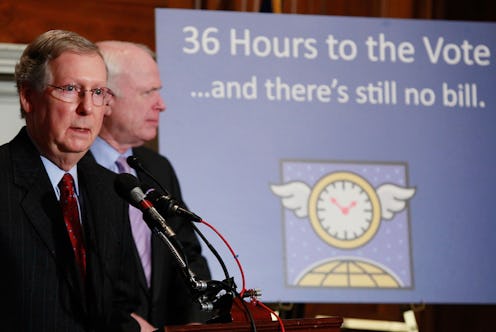
On Tuesday evening, Senate Republicans voted to proceed to open debate on health care reform and they're just getting started. The debate is expected to take up to 20 hours and will likely include the offering of many amendments. After debate closes, senators will then embark on a health care bill "vote-a-rama."
A vote-a-rama is (perhaps surprisingly) the official term for the rapid-fire amendment voting process that occurs after debate closes during the Senate budget reconciliation process. As a reminder, Senate Republicans are using the budget reconciliation process to try to secure enough votes for health care reform, since budget reconciliation only requires a simple majority to pass legislation as opposed to the traditional legislative process, which requires a filibuster-proof 60 votes.
During budget reconciliation, debate is limited to 20 hours. This debate time is split evenly between Republicans and Democrats. During the debate process, legislators can offer amendments, debate specific amendments, and even vote on these amendments. Indeed, on Tuesday evening, Senators voted down an amendment proposed by Senate Majority Leader Mitch McConnell that sought to pass the Senate version of the Obamacare replacement bill, the Better Care Reconciliation Act (BCRA).
However, while amendment votes can occur during the 20-hour debate process, since time is limited, many more amendment votes will likely occur after debate closes, during the vote-a-rama process. According to The Atlantic, votes during the vote-a-rama process typically occur in rapid-fire fashion.
Senators can also offer new amendments during the vote-a-rama process. According to CNN, dozens, if not hundreds, of amendments are expected during the vote-a-rama, particularly from Senate Democrats who, according to the network, wish to make their Republican colleagues vote on as many "politically damaging" amendments as possible.
Many news outlets have noted that the vote-a-rama process could last for hours upon hours, as a result of the aforementioned very high number of amendments anticipated. Once the end of the vote-a-rama process is finally reached, the Senate will then hold a final vote on the legislation with all of the approved amendments incorporated. This is the vote that will determine whether or not health care reform passes.
If legislation does indeed pass this final Senate vote, then it would likely be sent to a conference committee, where the differences between the House and Senate versions of the heath care bills would be reconciled. After the the conference committee process, the combined bill would then be sent to President Trump for his signature.
Of course, if no legislation passes the final Senate vote, then Republicans' attempts at health care reform will end, at least for the time being.
As you can see, the Senate legislative process to repeal and replace Obamacare will likely be long and arduous, particularly once the vote-a-rama begins after debate is closed. It will certainly be interesting to watch how the process unfolds, to say the very least.